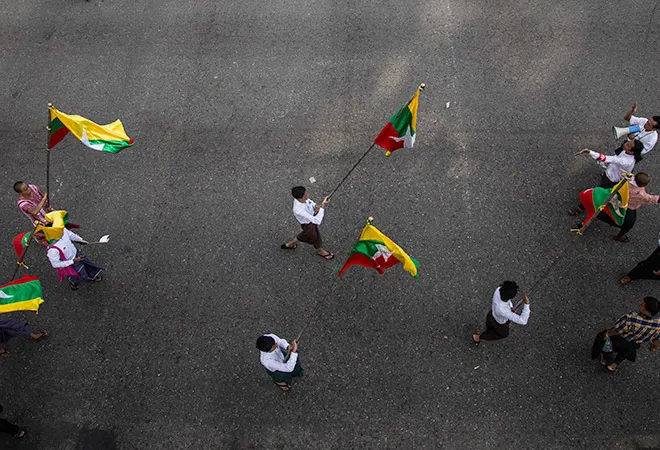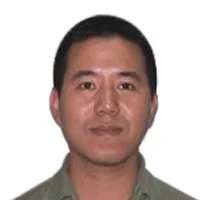
In a series of events that underline the waning of civil-military relations in Myanmar, the latest is the country’s army chief Min Aung Hlaing’s remarks in an interview given to a Russian magazine. He reportedly said: “ too dangerous for one person to be making decisions without consulting the relevant organisations and individuals for consideration.” The remarks are viewed as referring to State Counsellor Aung San Suu Kyi, who is also the leader of the ruling party, National League for Democracy (NLD).
When the NLD came to power in 2016 in a landslide victory in which its main election plank was democratisation of the constitution, the question many speculated was: To what extent would the civilian government and the armed forces (or the Tatmadaw) accommodate each other’s interests? The coming to power of the NLD party was a test for the power-sharing arrangement — enshrined in the military-drafted 2008 Constitution that guarantees the Tatmadaw’s role in politics with specials powers — as a party had long been the most vocal opposition to the undemocratic nature of the constitution.
With the country gearing up for another general elections in November this year — the third since political reforms were initiated in 2010 — it may be imperative to reflect on how the NLD government and the Tatmadaw managed their relationship in the past five years allowing them keep their differences from spiraling into open hostility.
The coming to power of the NLD party was a test for the power-sharing arrangement — enshrined in the military-drafted 2008 Constitution that guarantees the Tatmadaw’s role in politics with specials powers — as a party had long been the most vocal opposition to the undemocratic nature of the constitution.
The civilian political elites and the military generals perhaps considered that pushing one’s interests too hard might carry the risk of derailing the entire transition process. This might have allowed both sides to evolve a civil-military relationship driven primarily by pragmatism. In fact, until recently, this pragmatic cooperation and accommodation have played out in key areas that would otherwise be areas of confrontation between the civilian government and the Tatmadaw.
Even as the NLD’s core politics has been and remains to revolve around the question of further democratisation of the constitution, one can argue that the ruling party did not initiate any serious effort in bringing about constitutional change until last year. It was only in January 2019 that the NLD launched a parliamentary Charter Amendment Committee. However, the party’s bid to amend the Constitution could not be materialised.
Similarly, it was only recently that for the first time called the army chief has on the government to convene a meeting of the National Defence and Security Council (NDSC) — the 11-member council is the top decision-making body on security issues where the military holds a majority of six. The NLD government has not convened a single NDSC meeting since it came to power in 2016.
The NLD government and the Tatmadaw have also been trying to score political brownie points with eyes on the elections.
Following the first COVID-19 positive cases in Myanmar in late March, there was a proposal from the military-backed Union Solidarity and Development Party (USDP) to convene the NDSC. The proposal was rejected and the NLD government decided to form a joint civil-military committee tasked with controlling the spread the pandemic. This was again a clear sign of the NLD government sidestepping the NDSC.
The NLD government and the Tatmadaw have also been trying to score political brownie points with eyes on the elections. Even as the Tatmadaw continued to reiterate that it was extending support to and cooperation with the civilian government in the fight against the pandemic, it has been conducting medical assistances for various groups with the aim to project itself as an institution that is ready and prepared “to protect people from COVID-19.”
Recently, the army chief described the ethnic peace process under the NLD government as a failure and expressed displeasure at the civilian government’s inability to leverage the nine-month ceasefire with the ethnic armed groups that was announced by the Tatmadaw in 2019. Two days later, Aung San Suu Kyi said the peace process was on track and that it was set to proceed with the 4th Panglong peace conference scheduled later this month.
It is likely that the civil-military relationship may stabilise after the elections.
The two sides have also fought over symbols. In June, the military-backed USDP and 29 allied political parties demanded a ban on the use of images of the national hero General Aung San — the father of Aung San Suu Kyi — in electoral campaigns on the ground that it would favour the NLD party, though the election commission rebuffed the demand.
The pragmatic relationship that evolved over the past five years between the civilian government and the Tatmadaw is becoming increasingly difficult to sustain as the NLD and the Tatmadaw along with its proxy-parties position themselves as key opponents in the upcoming general elections.
It is likely that the civil-military relationship may stabilise after the elections, though the nature of that relationship will be spaded by the nature of the election outcome as well as changes within the Tatmadaw leadership and/or if the current army chief changes his mind, which looks unlikely in the foreseeable future.
The views expressed above belong to the author(s). ORF research and analyses now available on Telegram! Click here to access our curated content — blogs, longforms and interviews.




 PREV
PREV


